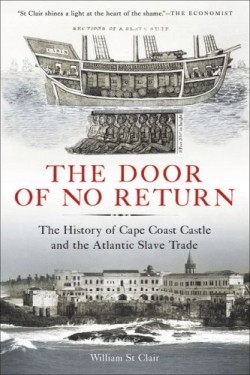The Door of No Return
The History of Cape Coast Castle and the Atlantic Slave Trade
Cape Coast Castle held no princesses or fairytales—only the bleakest nightmare. For 143 years, millions of enslaved Africans passed through its walls on their way to the Western hemisphere and chattel slavery. Situated on Africa’s west coast, the castle was the center of the British slave trade from 1664 until 1807. Out of the eleven million people who crossed the Atlantic to toil in slavery, about three million were carried on ships owned by British merchants or settlers.
William St Clair’s informative and well-researched book details life at the castle for those living both in its genteel upper half and its dungeon. Using journals, ships’ logs, correspondence, and negotiation notes, he illuminates the lives of those involved in the ugly business—from castle Governors and soldiers, to men on the slave ships waiting in the harbor, to the African people who facilitated the enterprise (occasionally becoming prey to the voracious appetite for human flesh themselves).
St Clair is an accomplished writer and was formerly a Senior Research Fellow at Trinity College, Cambridge University. His remarkable task of recovering from relative obscurity the cache of papers from both Cape Coast Castle and Africa House, the London headquarters of the trade, has produced a detailed account of this oft-neglected aspect of history.
While those living at the Castle or operating slave ships and plantations in the Americas had direct interactions with enslaved Africans, St Clair points out that the tentacles of slavery reached deep into the worldwide economy. From brick makers who produced materials to keep the Castle standing and ship builders who perfected the design of slave ships, to tobacco smokers and sugar consumers, wearers of cotton and rum drinkers, everyone in the “Europeanized world” was touched by the institution of slavery.
Both the body and the mind had to be “seasoned” to the African weather and the bloody business at hand. St Clair includes tales of people who lived (and usually died) in the “free” part of the Castle. He writes, “As important as the seasoning of the body, was the seasoning of the mind. As Archibald Dalzel wrote to his family in Scotland in 1763 shortly after his arrival, ‘I have at last, come into the Spirit of the Save trade, & must own (perhaps it ought to be to my Shame) that I can now traffick in that way without remorse.’”
With its accessible style and unique information, this book fills a gap and will become part of the continuing study of slavery. Those who passed through “The Door of No Return” deserve an honest reckoning of slavery’s impact on today’s culture.
Reviewed by
Deirdre Sinnott
Disclosure: This article is not an endorsement, but a review. The publisher of this book provided free copies of the book to have their book reviewed by a professional reviewer. No fee was paid by the publisher for this review. Foreword Reviews only recommends books that we love. Foreword Magazine, Inc. is disclosing this in accordance with the Federal Trade Commission’s 16 CFR, Part 255.

